Click on any picture below to see the un-cropped image.
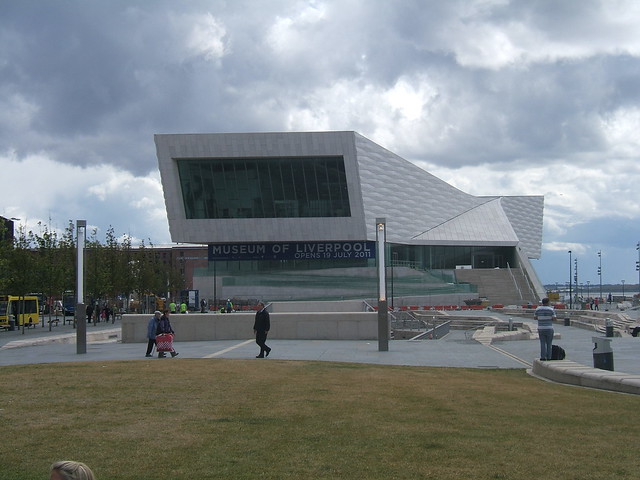 The Museum of Liverpool nears completion in July 2011.
The Museum of Liverpool nears completion in July 2011.
On Thursday 1st December 2011, Her Majesty the Queen, accompanied by His Royal Highness The Duke of Edinburgh, officially opened the Museum of Liverpool adjacent to the Pierhead in Liverpool. The museum first opened to the public on 19th July 2011, although not all the Galleries were complete at the time. On that occasion, I was not able to attend because of a trip to Russia but I believe a number of members of the Old Locomotive Committee (OLCO) were able to be there.
The Official Opening on the 1st December saw the unveiling of additional galleries - principally 'The Great Port' gallery in which the locomotive 'Lion' is displayed. John Hawley and Jan Ford were invited to the official opening, in recognition of their contribution to the Audio-Visual presentation describing 'Lion'. The filming of this contribution is briefly described in the post 'Lion Shoot'.
The Great and the Good arrived at the Museum around 08:30 for the Official Opening and refreshments were provided in 'The Waterfront Cafe'. At 09:30, visitors were directed to their allocated positions, prior to the arrival of the Royal Party at around 10:00. It had been arranged that the Queen and the Duke would make separate tours - the Duke was to visit 'The Great Port' gallery which has 'Lion' as the central exhibit.
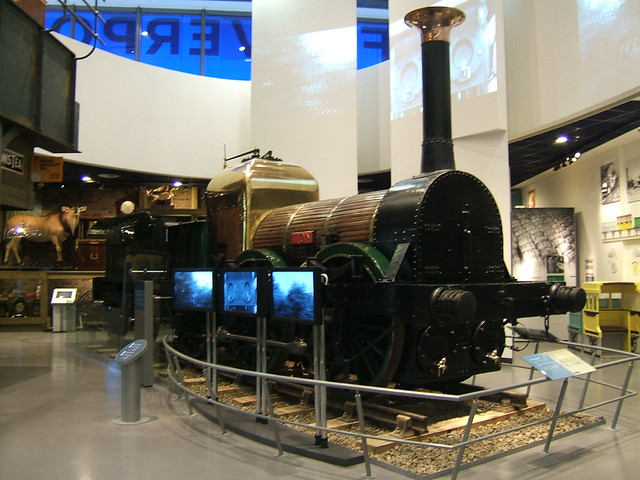 'Lion' is the centre piece of 'The Great Port' gallery.
'Lion' is the centre piece of 'The Great Port' gallery.
Although OLCO has never concealed its disappointment that 'Lion' would not be allowed to steam again, it has remained committed to assisting the Museum of Liverpool in the interpretation of the locomotive within the gallery. In acknowledgment of that support, Jan Ford (as current Secretary representing the entire membership of OLCO) was allocated to the small 'meeting group' at the entrance to 'The Great Port' Gallery whose members were presented to the Duke of Edinburgh. In reply to the Duke's question "What do you do?" I briefly outlined the role of OLCO as a "supporters' group" for 'Lion', independent from the museum. The Duke asked about the size of our membership and I replied "Around 70". After all the members of the 'meeting group' had been presented to the Duke, the Museum's Chairman, Phil Redmond, then led the Duke in a brief circuit of the gallery with the 'meeting group' following behind in case of further queries. The Duke's Equerry engaged me in a brief conversation about 'Lion' and soon the guests moved on to other galleries.
We then gathered in the large reception area until the Queen and the Duke had completed their separate tours. The Queen then unveiled a perspex plaque commemorating the official opening before she and the Duke were invited to sign the Visitors' Book. After receiving a posy from a seven year old boy and speaking briefly to the Mayoral Party and various Civic Officials, the Royal Party walked to the waiting limousine outside. The convoy of nine vehicles left just on 11:00.
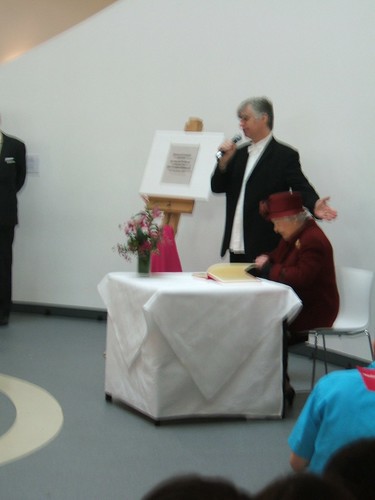 Having unveiled the plaque (on the easel in the background), Her Majesty is invited to sign the Visitors' Book.
Having unveiled the plaque (on the easel in the background), Her Majesty is invited to sign the Visitors' Book.
Light refreshments were provided to the invited guests under the designation 'Brunch'. The galleries remained open for the rest of the day solely for the invited guests and the front doors remained closed to the public. The following day was the first day of public access and large visitor numbers are anticipated.
So what of the Museum? I'm too much of a traditionalist to approve of what has been called rather unkindly 'The Dented Shoebox' architectural design (see heading picture)and I'm not too sure about the 72 million pound price tag. But I was impressed with the attempts made in all the galleries to convey information about the topic in a lively manner. This is largely based on the use of state-of-the-art Audio-Visual systems and, where appropriate, interviews with people who have experience of the topic and can provide 'Oral Histories'. For a little more information on the technology behind these Audio-Visual presentations, go to the post 'Audio Visual Installations at the Museum of Liverpool'.
As far as 'Lion' is concerned, locomotive and tender are displayed on a short length of ballasted bullhead track surrounded by stainless steel railings (see photograph above). There are a few labels attached to the railings with certain data about 'Lion' but most information is presented on a group of three high-definition flat-screen displays mounted at a convenient height on stainless steel posts along the right hand side of the locomotive. In the quiescent state, a series of black and white images is continuously presented on these three screens but a small pedestal allows either of two short colour productions to be displayed on demand by a simple button press.
 The small pedestal allows selection of either of two presentations.
The small pedestal allows selection of either of two presentations.
The first is called 'Railways are the future'. This is an imagined conversation taking place in 1838 during a journey by train between George Stephenson and a railway shareholder.
The second is called 'Lion takes centre stage - The Old Locomotive Committee discusses Lion'. This comprises ad lib 'pieces to camera' by John Hawley and Jan Ford filmed in the 'Lion Tavern' talking about 'Lion' and her history intercut with archive film of 'Lion' and 'snippets' from 'The Titfield Thunderbolt'. This presentation includes video of 'Lion' recorded during the Sesquicentenary celebrations showing the locomotive operating at Manchester Museum of Science and Industry, Birmingham Railway Museum and The Science Museum Wroughton Open Day.
In the picture above of 'Lion', you can also see three large projected images at high level. Normally, these cycle through various black and white images showing the Port of Liverpool and 'Lion'. I understand that, periodically during the day, these will provide a further presentation on 'Lion' but, on the day of the Royal Visit, this feature was not in use.
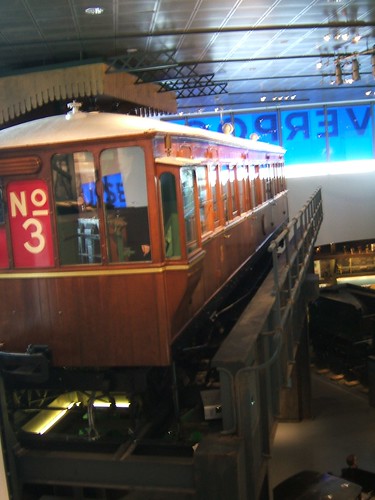 The preserved Liverpool Overhead Railway coach.
The preserved Liverpool Overhead Railway coach.
The preserved Liverpool Overhead Railway Coach is displayed at high level adjacent to 'Lion' on a short length of simulated overhead railway viaduct. There's a little about this railway here, with links to more pictures of this coach. Visitors to the museum can enter part of the coach from the first floor and sound effects are provided.
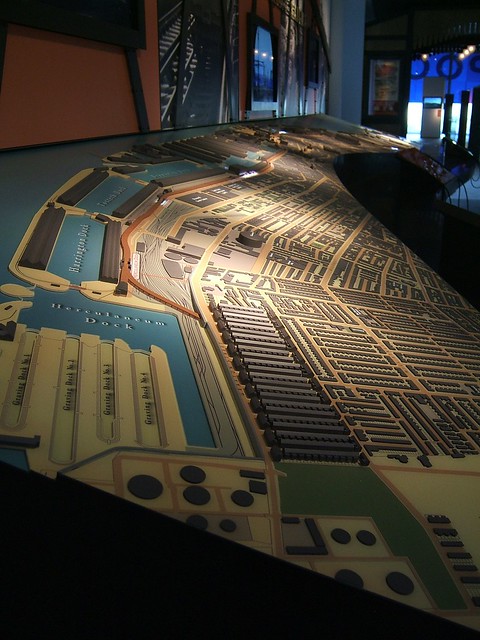 The large model of the docks and the route of the Liverpool Overhead Railway, viewed from the Dingle end (where the railway ran underground to reach Dingle Station).
The large model of the docks and the route of the Liverpool Overhead Railway, viewed from the Dingle end (where the railway ran underground to reach Dingle Station).
Quite a lot of information on the Liverpool Overhead Railway is presented on the first floor of the museum. I was particularly taken with a large model of the route, where white lights (representing trains) move up and down the route, pausing briefly at each station.
Sadly, there was insufficient space to display the preserved Mersey Docks and Harbour Board 0-6-0 saddle tank in the museum (there are a few pictures of the locomotive in store here) but the Sentinel Steam Tractor is on show (my earlier pictures are here).
In the four months since the museum first opened, I understand it's attracted around half a million visitors. Now the additional galleries are open, it is anticipated that the museum will be even busier!
My camera coped poorly with the museum lighting conditions but I've nontheless posted the results in Royal Visit.
